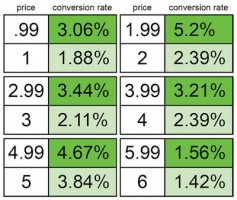So you’ve finally made the decision of being an entrepreneur. You’ve decided to enter the market and offer the best products / services that you can offer. You may be a web developer, a web designer, a domain reseller looking to start your own business. You’ve narrowed down your target audience, you have a business model but unsure how to tackle the challenging decision of price setting. We’re here to help you with that one critical business decisions.
It can be difficult to set a price for a custom product or service mainly because the product may be new & hence there isn’t an existing market price for it. Even if there is an existing, similar product, you can risk setting a price too low for profits or too high for demand. Here are tips to help you put an appropriate price on the tag:
State your price before you take on the project: When you’re approached by a client for a quote, as a professional, based on the items/ services requested for, you should be able to state a price. It will give your client a chance to assess the cost & the breakdown & draw up a contract. Additional alterations should be charged as extra depending on the labor put in, the resources spent & the additional material required.
Cost of materials + Markup%: Calculate your expenditure on the product including electricity, material, skill, expertise. Once you’ve arrived at a figure, add a markup % (Could be anywhere between 20% to 80% depending on the competitiveness of the market that serves your target audience) additional charge to arrive at a suitable selling price. In some countries where expertise is relatively cheaper, it is common to find a 100% extra charge or even more than 100%.
Choosing a figure: Charm Pricing, as it is called refers to the positive effect of prices that end in a 9,99 or 95. Additionally, it is to be noted that Charm Pricing is most effective when the left digit changes. For example, $1.19 changing to $1.09 will not make as much of a difference. However, changing a $1.00 to a $0.99 makes quite a difference as proven in this table below:

(Source: Gumroad)
Assess your time on the project: When you begin a project, you may make an estimation of the time spent on the product, therefore risking over charging or undercharging. To avoid such cases, it is a good idea to track your time spent on the project and ultimately evaluate how much you’ll end up earning in the near future. If you find yourself spending a considerable amount of time on the project, you will set an optimal price for the labour inputted. Every minute counts! Here are two applications we think are useful for tracking time on your projects:
a. Proworkflow: Keep a track on all your projects, tasks, finances & reports. Accurately track your time spent on tasks & great for schedule management
b. Toggl – Track time spent on your project in real time & mark it as ‘billable’
Assess the Quality you offer: It’s important to compare the quality of your products with that of your competition. If you’re offering additional products, freebies or superior services than your competition then you’re at a liberty to charge a higher rate solely due to the quality you offer. If you do offer quality services, gradually, your customers will value you without questioning your rate.
Make a separate mention for maintenance charges: This means breaking up your total cost into product price + maintenance price. Make it clear that you will be charging additionally for upgrades, website maintenance etc. “Partitioning pricing” has been proven to be more effective because people are more likely to compare your base price to the price of a competition product. If your base price looks lesser than competition, they are more likely to pick your product.
Payments in Installments & Daily Equivalence: It’s all about perception. Compare this: $699 for your product vs. $99 for 6 months in easy installments. The second option creates a perception of a lower cost although it is essentially the same.
Bundling Your Products: As a reseller, you have access to a wide variety of products & services- Domains, hosting products, website builder, customer support, security certificates, apps etc. It’s a good idea to bundle some products & offer a whole price so your customer can’t put a price on a single product.
Daily Equivalence also creates the same effect. Stating your price as $0.99/ day vs. $29.99 looks considerably more ‘affordable’ and hence more likely to work.
These tips should help you arrive at a price suitable for you and your customers. If you’ve got more tips, please share them in the comments section below! Go ahead & try these tips & tell us if they’ve worked for you!
There is no ads to display, Please add some



